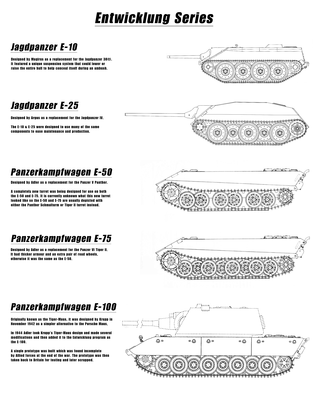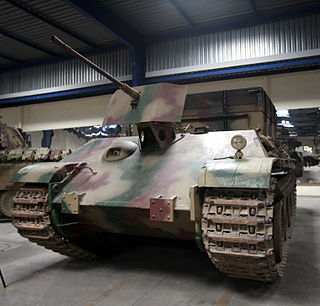
The Minenabwurfvorrichtung was an anti-personnel mine launcher used to disperse S-Mines. It was typically found on German tanks such as the Panzer III and Tiger I from 1942 through 1943.

The Minenabwurfvorrichtung was an anti-personnel mine launcher used to disperse S-Mines. It was typically found on German tanks such as the Panzer III and Tiger I from 1942 through 1943.
The Minenabwurfvorrichtung was a simple device consisting of a small steel tube oriented at a 50° angle mounted to the hull roof or track guards of the tank. The tube contained a modified version of the infantry S-mine [1] equipped with the Glühzünder 28 fuze which allowed it to be electrically fired from the inside of the vehicle using a small control panel [2] labeled Minenabwurfschalter that was mounted on the engine firewall. [3] The mine itself consisted of a round projectile 130 millimetres (5 in) deep by 122 millimetres (5 in) [4] wide and contained about 360 steel balls. The projectile was fired about 0.9 to 1.5 meters (3 to 5 ft) into the air, where it would explode, scattering the steel balls in all directions. [5] Starting in June 1942, up to six launchers were mounted on the track guards of an unknown number of Panzerkampfwagen III Ausführung L tanks and were issued for troop testing to the 13th Panzer Division. [6] The device was subsequently adopted as standard equipment on new production Tiger I tanks during January through October 1943. [7] On the standard Tiger I, five launchers (four on Panzerbefehlswagen ) were mounted around the periphery of the hull roof, one at each corner and one halfway along the left hull side. As future plans were being made to install the 360° traversable Nahverteidigungswaffe, fired from the interior of the turret, the Minenabwurfvorrichtung was discontinued in early October 1943 [8] after only a few hundred Tiger Is had been equipped with them. [9]

The Tiger II is a German heavy tank of the Second World War. The final official German designation was Panzerkampfwagen Tiger Ausf. B, often shortened to Tiger B. The ordnance inventory designation was Sd.Kfz. 182.. It was also known informally as the Königstiger. Contemporaneous Allied soldiers usually called it the King Tiger or Royal Tiger.

The Panzer II is the common name used for a family of German tanks used in World War II. The official German designation was Panzerkampfwagen II.

The Panzerkampfwagen III, commonly known as the Panzer III, was a medium tank developed in the 1930s by Germany, and was used extensively in World War II. The official German ordnance designation was Sd.Kfz. 141. It was intended to fight other armoured fighting vehicles and serve alongside and support the similar Panzer IV, which was originally designed for infantry support. However, as the Germans faced the Soviet T-34 and KV-1, more powerful anti-tank guns were needed, and since the Panzer IV had more development potential with a larger turret ring, it was redesigned to mount the long-barrelled 7.5 cm KwK 40 gun. The Panzer III effectively swapped roles with the Panzer IV, as from 1942 the last version of the Panzer III mounted the 7.5 cm KwK 37 L/24 that was better suited for infantry support. Production of the Panzer III ceased in 1943. Nevertheless, the Panzer III's capable chassis provided hulls for the Sturmgeschütz III assault gun until the end of the war.

The Panzerkampfwagen IV, commonly known as the Panzer IV, was a German medium tank developed in the late 1930s and used extensively during the Second World War. Its ordnance inventory designation was Sd.Kfz. 161.

Panzerkampfwagen VIII Maus was a German World War II super-heavy tank completed in late 1944. It is the heaviest fully enclosed armored fighting vehicle ever built. Five were ordered, but only two hulls and one turret were completed, the turret being attached before the testing grounds were captured by advancing Soviet military forces. This vehicle was also built to compete with the Soviet heavy tank the Kliment Voroshilov tank.

The Panther tank, officially Panzerkampfwagen V Panther with ordnance inventory designation: Sd.Kfz. 171, is a German medium tank of World War II. It was used on the Eastern and Western Fronts from mid-1943 to the end of the war in May 1945.

Sturmtiger was a World War II German assault gun built on the Tiger I chassis and armed with a 380mm rocket-propelled mortar. The official German designation was Sturmmörserwagen 606/4 mit 38 cm RW 61. Its primary task was to provide heavy fire support for infantry units fighting in urban areas. The few vehicles produced fought in the Warsaw Uprising, the Battle of the Bulge and the Battle of the Reichswald. The fighting vehicle was known by various informal names, among which the Sturmtiger became the most popular.

The Panzerjäger I was the first German tank destroyer to see service in the Second World War. All mounted the Czech Škoda-built 4.7 cm KPÚV vz. 38 antitank gun on a converted Panzer I Ausf. B chassis. It was intended to counter heavy French tanks like the Char B1 bis that were beyond the capabilities of the 3.7 cm Pak 36 anti-tank gun and extended the life of the obsolete Panzer I chassis. A total of 202 Panzer I chassis were converted to Panzerjäger I standard in 1940–41, and were employed in the Battle of France, in the North Africa Campaign and on the Eastern Front.

The Nahverteidigungswaffe was a roof mounted, breech-loaded, single shot, multi-purpose, 360° rotating grenade launcher that could fire a variety of ammunition. It was typically found on German tanks such as the Panzer IV, Panther I, Tiger I, and Tiger II from 1944 until the end of the war and was intended to replace three previous devices: the Nebelwurfgerät, the Minenabwurfvorrichtung, and pistol ports.

Nazi Germany developed numerous tank designs used in World War II. In addition to domestic designs, Germany also used various captured and foreign-built tanks.

The Entwicklung series, more commonly known as the E-Series, was a late-World War II attempt by Nazi Germany to produce a standardised series of tank designs. There were to be standard designs in five different weight classes from which several specialised variants were to be developed. This intended to reverse the favor of extremely complex tank designs that had resulted in poor production rates and mechanical unreliability.

The 5 cm KwK 38 L/42(5 cm Kampfwagenkanone 38 L/42) was a German 50 mm calibre cannon used as the main armament of variants of the German Sd.Kfz. 141 Panzerkampfwagen III medium tank during the Second World War..

The Bergepanzerwagen V, often referred to as the "Bergepanther", was an armoured recovery vehicle used by the German Army in WWII. It was a variant of the Panzerkampfwagen V Panther.

The Tiger I was a German heavy tank of World War II that operated beginning in 1942 in Africa and in the Soviet Union, usually in independent heavy tank battalions. It gave the German Army its first armoured fighting vehicle that mounted the 8.8 cm KwK 36 gun. 1,347 were built between August 1942 and August 1944. After August 1944, production of the Tiger I was phased out in favour of the Tiger II.

The VK 30.01 (P) was the official designation for a heavy tank prototype proposed in Germany. Only two prototype chassis were built. The tank never entered serial production, but was further developed into the VK 45.01 Tiger (P). Porsche called it the Typ (Type) 100.
The VK 45.01 (P), also informally known as Tiger (P) or Porsche Tiger, was a gasoline-electric drive heavy tank prototype designed by Porsche in Germany. Losing to its Henschel competitor on trials, it was not selected for mass production and the Henschel design was produced as the Tiger I. Most of the already produced chassis were rebuilt as Elefant tank destroyers.

The IS-2 is a Soviet heavy tank, the first of the IS tank series named after the Soviet leader Joseph Stalin. It was developed and saw combat during World War II and saw service in other Soviet allied countries after the war.

The Nebelkerzenabwurfvorrichtung was a rear mounted grenade dispenser used to disperse the Schnellnebelkerze 39 smoke grenade. It was typically found on German tanks from 1939 through 1942.

The Nebelwurfgerät was a turret mounted launcher used to disperse the Schnellnebelkerze 39 smoke grenade. It was typically found on German tanks from 1942 through 1943.